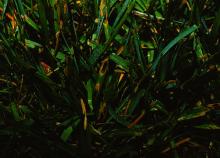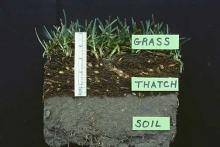See:
Grass for Seed - Drechslera Leaf Blights (Helminthosporium Net Blotch)
Hosts Kentucky and other bluegrasses and perennial ryegrass.
Cause Drechslera poae and other Drechslera sp. species, fungi. This disease is the limiting factor in growing Kentucky bluegrass in western Oregon but is not much of a problem in eastern Oregon. The fungus survives unfavorable conditions in plant debris or infected plants. Leaf infections are most common in cooler months. Conidia spread by wind, splashing rain, grass clippings, or by equipment. The disease is worse on turf cut short.
Symptoms Tiny, water-soaked lesions turn purple with straw-color centers. Lesions may girdle leaves. The turf stand turns brown, becomes thin, and looks drought stressed.
Cultural control
- Plant resistant cultivars that have been shown to do well in the Pacific Northwest.
- When planting bluegrass, use mixtures with other grasses less susceptible to this disease.
- Avoid excess nitrogen through fall and winter.
- Mow 1.5 to 2 inches tall and remove clippings.
- Remove excess thatch in early spring and aerify if needed to provide good aerification and drainage.
Chemical control Scout through fall and winter. Treat when 10% of the turf is affected. Applying to home lawns is not recommended because damage usually is done before the disease is noticed. Note: Avoid using fungicides containing Group 1 fungicides (such as Cleary's 3336 or OHP 6672) on affected lawns because they can increase the severity of the disease. To prevent developing resistant fungi, alternate or tank-mix materials from different groups with different modes of action.
- Chipco 26019 FLO at 3 to 4 fl oz/1,000 sq ft. Group 2 fungicide. 12-hr reentry.
- Compass 50 WDG at 0.1 to 0.25 oz/1,000 sq ft. Do not use organosilicate additives. Group 11 fungicide. 12-hr reentry.
- Daconil Weather Stik at 2 to 5.5 fl oz/1,000 sq ft depending on whether the application is preventive or curative. Group M5 fungicide. 12-hr reentry.
- Eagle 20 EW at 1.2 fl oz/1,000 sq ft. May produce a growth regulation effect on Kentucky bluegrass. Group 3 fungicide. 24-hr reentry.
- Fame SC at 0.2 to 0.4 fl oz/1,000 sq ft. Group 11 fungicide. 12-hr reentry.
- Floxcor at 0.18 to 0.36 fl oz/1,000 sq ft plus an adjuvant. Group 11 fungicide. 12-hr reentry.
- Heritage at 0.2 to 0.4 oz/1,000 sq ft. 4-hr reentry.
- Insignia SC at 0.4 to 0.7 fl oz/1,000 sq ft. Do not use with organosilicate adjuvants. Group 11 fungicide. 12-hr reentry.
- Mancozeb 80% (Fore, Manzate, and Protect DF) at 4 oz/1,000 sq ft. Group M3 fungicide. 24-hr reentry.
- Medallion SC at 1 to 2 fl oz/1,000 sq ft. Apply after mowing. Using with oils or adjuvants may damage plant. Group 12 fungicide. 12-hr reentry.
- Previa at 2 to 5.5 fl oz/1,000 sq ft. Group M5 fungicide. 12-hr reentry.
- Propiconazole-based products. Group 3 fungicides.
- Banner MAXX at 1 to 2 fl oz/1,000 sq ft. 12-hr reentry.
- PropiMax EC at 0.37 to 0.73 fl oz/1,000 sq ft. 12-hr reentry.
- Secure at 0.5 fl oz/1,000 sq ft. Group 29 fungicide. Reentry when sprays have dried.
- Spotrete F at 3.75 to 7.5 fl oz/1,000 sq ft. Group M3 fungicide. 24-hr reentry.
- Trinity at 0.5 to 2 fl oz/1,000 sq ft. Do not mix with growth regulators during hot weather as injury may develop. Group 3 fungicide. 12-hr reentry.
- Velista at 0.3 to 0.5 oz/1,000 sq ft. Group 7 fungicide. 12-hr reentry.
- Xzemplar at 0.26 fl oz/1,000 sq ft. Group 7 fungicide. 12-hr reentry.
Combination Fungicides
- Armada 50 WDG at 0.6 to 1.5 oz/1,000 sq ft. Do not use a silicone-based surfactant. Group 3 + 11 fungicide. 12-hr reentry.
- Briskway at 0.5 to 1.2 fl oz/1,000 sq ft. Can be used in hot weather. Group 3 + 11 fungicide. Reentry when sprays have dried.
- Concert at 3.5 to 8.3 fl oz/1,000 sq ft. Do not use on fine fescue turf. Group 3 + M5 fungicide. 12-hr reentry.
- Encartis at 3 to 4 fl oz/1,000 sq ft. Do not use with oil-based pesticides. Group 7 + M5 fungicide. Reentry when sprays have dried.
- Headway at 1.5 to 3 fl oz/1,000 sq ft. Do not use with silicone-based surfactants or EC formulations. Group 3 + 11 fungicide. 12-hr reentry.
- Heritage Action at 0.2 to 0.4 oz/1,000 sq ft. Group 11 + P1 fungicide. 12-hr reentry.
- Honor at 0.55 to 1.1 oz/1,000 sq ft. Do not use with organosilicone-based adjuvants. Group 7 + 11 fungicide. Golf course turf only.
- Interface at 3 to 5 fl oz/1,000 sq ft. Maintain agitation while spraying. Do not mix with adjuvants. Group 2 + 11 fungicide. 24-hr reentry.
- Lexicon at 0.34 to 0.47 fl oz/1,000 sq ft. Group 7 + 11 fungicide. 12-hr reentry.
- Navicon at 0.7 to 0.85 fl oz/1,000 sq ft. Group 3 + 11 fungicide. 12-hr reentry.
- Pillar G at 3 lb/1,000 sq ft. Group 3 + 11 fungicide. 12-hr reentry.
- Renown at 2.5 to 4.5 fl oz/1,000 sq ft. Group M5 + 11 fungicide. 12-hr reentry.
- Tartan at 1 to 2 fl oz/1,000 sq ft. Group 3 + 11 fungicide. 12-hr reentry.
Reference Czembor, E. 2004. Resistance of European ecotypes of Kentucky bluegrass (Poa pratensis) to Drechslera poae under greenhouse conditions. Australasian Plant Pathology 33:437-439.



